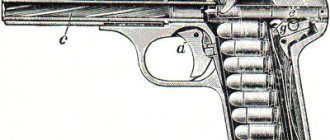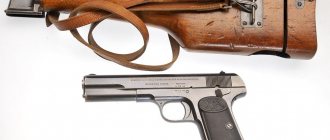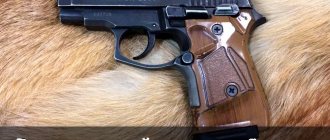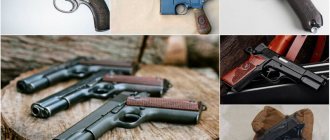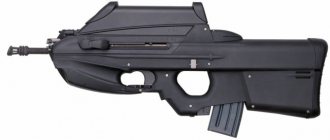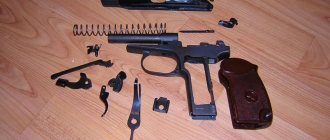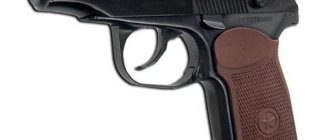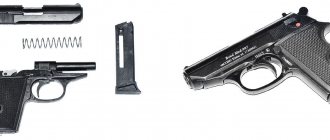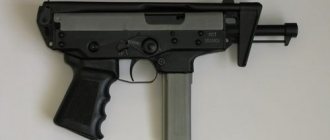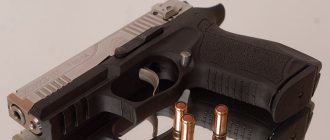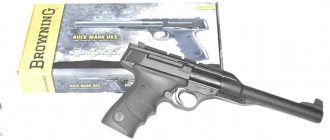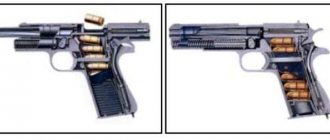The original name Five-seveN means the caliber of the pistol (5.7 mm), and if you put the first and last letters together separately (they are written in capitals in the name of the pistol), we will see the abbreviation FN, the name of the Belgian company that produces this firearm. This is such an unusual naming.
Reference. “FN Herstal (French Fabrique Nationale d'l, variant names: Fabrique Nationale, FN, “National Factory in Herstal”) is a Belgian arms company, part of the Herstal Group, which also owns such weapons manufacturers as the American Winchester Repeating Arms Company and Browning Arms Company." Source: Wikipedia.
The history of the creation of this pistol is extremely simple. The Belgian company FN Herstal created from scratch in the early 90s of the 20th century the “personal weapon of a serviceman” FN P90, reminiscent of a blaster from a science-fiction film with a huge 50-round magazine, and a bottle-shaped cartridge with high “penetrating” characteristics. And in tandem with this “submachine gun” she created a pistol chambered for the same cartridge. The start of development was announced in 1995, the pistol itself “appeared on the shelves” in 1998. That’s it.
FN Five-seveN Photo: ru.wikipedia.org
From the history of weapons: the distant ancestors of the FN Five-seveN are the Mauser K-96 and other “carbine pistols” (with a bottle-shaped pistol cartridge, reminiscent of a rifle), and the closest is the TT pistol (Tula Tokarev), also precisely because of the ammunition bottle-shaped, used simultaneously in both individual (pistol) and assault (submachine gun) weapons.
The design of the pistol, based on an automatic semi-blowback, is relatively complex, but proven and reliable. The barrel is locked by turning the bolt.
9-mm Mauser K96 pistol with a holster-butt Photo: ru.wikipedia.org
The tactical niche of this interesting pistol is targets dressed in light body armor made of Kevlar or liquid armor. What is Kevlar? This is a material whose strength, as Wikipedia says, is five times higher than steel. Lightweight body armor is made from Kevlar fabric. So, a bullet, hitting such a bulletproof vest, partially pushes the fabric fibers apart and partially tears them. Naturally, it is much easier to move the fibers apart than to tear the strongest threads. And the smaller the caliber of the bullet, the less the fibers tear and the more they move apart. Consequently, a bullet of a smaller caliber, all other things being equal, loses less energy when penetrating such body armor.
With liquid armor the situation is even more interesting. Liquid armor is a gel that turns into a supersolid substance upon impact. But not instantly, but at a certain speed. The maximum bullet speed at which the gel has time to “thicken” is approximately 600 m/sec. If the speed of the bullet is even a little higher, the body armor penetrates without any effort, the bullet simply does not meet resistance. That is why the cartridge for the civilian market (SS197) has a bullet speed at the exit of the barrel that is limited to 520 m/sec, which does not allow it to penetrate a police bulletproof vest made of liquid armor. In the police (SS195) and military (SS190) versions of the 5.7x28 mm cartridge, the exit velocity of the bullet is above 600 m/sec; in this version, a pistol shot easily penetrates the standard NATO CRISAT body armor.
5.7x28mm cartridges used in Five-seveN. From left to right: SS195LF hollow point, SS196SR V-Max, and SS197SR V-Max Photo: ru.wikipedia.org
Performance characteristics:
Caliber: 5.7×28 mm. Length: 208 mm. Barrel length: 122.5 mm. Weight: 618 g without cartridges. Magazine capacity: 10, 20 or 30 rounds. Aimed firing range: up to 150 m. Maximum bullet flight range: over 1500 m.
Five-seveN pistol chambered for 5.7x28
In the article about the P90 submachine gun, you could get acquainted with the 5.7x28 cartridge, but the submachine gun described in the article is not the only weapon chambered for this cartridge. In addition to this sample, there is also a pistol with a fairly large magazine capacity, while the length of the weapon’s handle remains within reasonable limits. We are talking about a pistol from the FN Five-Seven company, or more correctly, Five-seveN, since this is the name of the weapon declared by the manufacturer and the abbreviation of the company name is indicated in capital letters. It is with this sample, or rather with several variants of this pistol, that we will try to get acquainted in this article.
This sample pistol appeared as an addition to the P90 submachine gun, so we can already talk about a cartridge-weapon complex, and not about a single copy. Considering that the submachine gun itself turned out to be quite unusual, many expect that the pistol will also be a not entirely classic design, but this is absolutely not the case. Although if you look at the weapon carefully, you will notice that many aspects of it are really interesting and deserve, if not praise, then at least attention, but in general, nothing super new has been used in the weapon. The pistol was developed back in the late 80s of the last century, but its production was launched only in 1998. It was then that the first version of this weapon appeared.
The first version of the pistol was offered to the army as a weapon for personal protection. Indeed, this pistol is always ready to fire. It uses only a double-action trigger mechanism, that is, before each shot, when you press the trigger, it is cocked and then released. In addition, there is an automatic safety that blocks the firing pin until the trigger is fully pulled, which prevents accidental firing, even if the cartridge is in the chamber. Accidental pressing of the trigger is also partially excluded, since the pressing force due to self-cocking is quite large. Thus, this pistol turns out to be a “pull-and-shoot” weapon, but at the same time quite safe to wear. The distinctive feature of this pistol is that it does not have a safety switch, and its safety guard is quite complex in shape. Sights consist of a front sight, which is made as a separate part from the bolt casing, as well as the whole thing, which is installed on a dovetail-type seat. Under the barrel of the weapon, in the frame there is a seat for additional devices, such as a compact flashlight for target illumination or a laser target designator. The magazine with a capacity of 20 rounds is locked using a button on the left side of the weapon.
Some time after the release of the army version of the pistol, an option for the police was proposed. Despite its external similarity with the previous version of the weapon, this pistol is somewhat different in its design and design. First of all, the main difference is the single-action trigger mechanism, that is, before firing, you need to pull the bolt back to cock the firing mechanism; naturally, after each shot, this all happens automatically. In order to be able to safely carry a weapon with a cartridge in the chamber, a non-automatic fuse is provided. Thus, in order to prepare for a shot, the weapon must either be removed from the safety catch, or not use it and not carry a pistol with a cartridge in the chamber, pulling back the bolt if necessary to use the weapon. On the one hand, the fact that the pistol has to be prepared before use is a minus, but most models of pistols have this “minus”, so this is not worth taking into account, but the fact that when pressing the trigger you need to apply less force compared to the previous version of the pistol, and this is, of course, a plus, since thanks to this the shooting accuracy is significantly increased, but on the contrary, comparatively. In all other respects, the weapon was completely similar to the previous model. This sample had a prefix to the name Tactical.
The production of this pistol did not last long; already in 2004, this model was replaced by a pistol marked IOM (Individual Officers Model). Despite its name, this pistol entered the civilian arms market, where people first became acquainted with it, but they already knew about the ammunition from the civilian version of the P90 without the possibility of automatic fire. Externally, this pistol can be distinguished by the Picatinny rail under the barrel on the weapon frame, as well as by the new shape of the bolt casing. Internally, this pistol has not changed compared to the previous model. True, the weapon was supplemented with one more feature that made it safer, namely an automatic magazine safety. This addition is necessary primarily due to the fact that cases when the owner removes the magazine from the pistol and believes that after that the weapon is completely safe are not at all uncommon. As a result of this, a cartridge remains in the chamber of the pistol and, despite the absence of a magazine, the pistol is completely ready to fire, in fact this is the reason for frequent accidents with pistols, and not only with them. With the Five-seveN IOM pistol, this situation is excluded, since a shot without an inserted magazine is impossible. But this weapon was produced for only a short time, and soon the company presented the next version of the pistol, this time the final one.
The next version of the weapon received the name Five-seveN USG (United States Government), after this version of the weapon went into mass production, other models were discontinued and at the moment this pistol is the only mass-produced version of the weapon. Externally, the pistol is very easy to recognize and distinguish from other previous versions; the whole point is that in this pistol the safety guard is no longer of a complex shape, but ordinary, large, straight, which turned out to be much more convenient than previous versions. In general, it seems to me that the previous versions of the safety brackets were made only so that the weapon would be recognizable, but when it had already gained some popularity, they decided to return to the “classics”. The sighting devices have also undergone changes. At first, the rear sight of the pistol was adjustable, then options with a non-adjustable rear sight appeared, and then both versions of sighting devices could be found in the weapon set, and it was easy to replace them yourself, since they were removable. At the moment, various versions of this pistol are offered, and the variety even concerns the texture of the weapon’s handle, which, in my opinion, is clearly too much. Even the linings on the bolt casing, which are made for more comfortable holding, can have both notches and simply bulges, while they are removable and the shooter can choose what he likes best. The trigger mechanism of the pistol is the same as in previous models except for the first single action.
As you can see, the layout of the controls is the same in all weapon variants. So, in all but the first version of the pistol, there are very small safety levers, which are duplicated on both sides of the weapon. These switches are located above the trigger of the pistol, which requires a certain habit, since switching them is now most conveniently done with the index finger of the holding hand. According to the designers, this reduces the time required to prepare for the first shot. To disassemble the weapon, it is enough to pull the bolt all the way back, lock it and press the pistol barrel lock, after which the bolt casing is smoothly moved forward, being removed from the pistol, and the barrel itself, with the return spring wrapped around it, is separated from the frame of the weapon. The interesting thing about all this is that the return spring itself, firstly, is wrapped around the barrel, and secondly, the return spring is fixed and cannot fly off the barrel of the weapon and get lost, which is a plus when servicing in the field, when everything is done literally I mean, on the knee. A noteworthy point is that the company’s specialists prohibit further disassembly of the weapon, and now you can think about this. Either the gun is not as simple and well thought out as it seems, or too many people have their hands growing in the wrong place, so a complete disassembly should be done for them by a qualified specialist, as required by the company. The only point that remains unclear to me is whether the warranty on the weapon is lost if it is completely disassembled and reassembled.
Well, now the most important thing. Five-seveN pistols are built according to a semi-blowback design, no one knows how the designers managed to do this... Just kidding, this time everything is as simple as a shovel. Just look at the window for ejecting spent cartridges and estimate the thickness of the bolt casing, the weight of which is greater than the weight of the remaining components of the weapon. So there’s a stiff recoil spring, a heavy bolt, a housing-bolt barrel connection, and you can shoot 5.7x28 cartridges. Logically, the large weight of the bolt casing should have had a significant impact on the accuracy of the fire, but here the designers also thought of everything. The barrel of the weapon is low, therefore the recoil vector when firing is lower than that of other pistols. It is also important that the casing-bolt moves along the internal guides of the frame, which allows you to extend the service life of the weapon, since with this arrangement of parts the “looseness” during operation is lower , which inversely affects shooting accuracy. By the way, this is confirmed by the fact that the manufacturer guarantees more than 20 thousand shots from the weapon with proper care and maintenance, apparently servicing by specialists who can perform a complete disassembly.
Just like the P90 submachine gun, Five-seveN pistols leave a double impression. On the one hand, the weapon seems to be quite effective thanks to the ammunition against opponents wearing personal armor protection, but on the other hand, I personally don’t believe in the stopping effect of the 5.7x28 cartridge bullet. Thus, the weapon is mainly not intended for the civilian market because of its ammunition, since in the civilian market, it seems to me, pistols chambered for cartridges with heavy, albeit slower, bullets are more in demand.
In fact, this is confirmed by the fact that on the civilian market the popularity of this pistol was in the form of a flash - it appeared, they tried it, it was declared unsuitable. The weapon also did not catch on in the military environment; after all, both the cartridge itself and the weapon are unsuitable for widespread distribution, no matter how much sympathy one may feel for it, but many accepted the pistol for service. This weapon is used where a collision with an enemy protected by body armor is guaranteed, as well as where a weapon with an expanded magazine capacity is required. By the way, the pistol for the civilian market comes with magazines with a capacity of 10 rounds, where there is a limit on the amount of ammunition in the magazine. A standard magazine is considered to be a magazine with a capacity of 20 rounds; a magazine with an increased capacity holds 30 rounds, but at the same time protrudes down beyond the pistol grip.
Well, in conclusion, the most important thing is the numbers. The total length of the pistol with a barrel length of 122 millimeters is 208 millimeters. The height of the weapon with a standard magazine is 145 millimeters. The width of the pistol is considerable - 36 millimeters. The weapon weighs about 600 grams without cartridges, and the weight can vary within narrow limits due to the fact that the pistol handle can be equipped with various removable rear parts. The effective range of use of weapons is up to 50 meters, although the target can be confidently hit at a distance of 150 meters, how far the bullet flies while maintaining lethal energy, unfortunately, the data differs, so it is better to remain silent about them.
In general, such a weapon was created as a company for the P90 submachine gun
Damage with minimum rage
What happens if you shoot at point-blank range with Five Seven:
| Part of the body | With minimal rage | |
| Without armor | With armor | |
| Head | 125 | 114 |
| Hands | 30 | 27 |
| Body | 40 | 34 |
| Foots | 22 | 22 |
| Red is death! | ||
Interesting Facts
- The pistol has a similar firing speed as the Tec-9:
- In CS:GO there are 2 weapons whose country of origin is Belgium. The second is a cockerel (P90). They also fire bullets of the same caliber;
- In cs go, Five-SeveN has been greatly increased in damage;
- The Five Seven pistol is the only pistol that was approved by the developers for a very long time before its introduction. A large number of votes were against. But due to certain circumstances it was added, and it creates a certain balance in the game.
Gameplay - game tactics
Five-Seven is suitable for eco rounds. With this weapon you can compete almost equally with an assault rifle or submachine gun. The pistol is accurate when moving, which allows you to shoot efficiently on the move. Use this in battle.
Five Seven's first two shots are the most accurate. Release them, aiming for the head - the pistol kills in the head with one shot, even if the enemy has armor with a helmet.
Shoot while sitting at long distances - then Five Seven's accuracy will increase significantly.
Counter-tactics
- Five-Seven is weak at long range. Use this and purchase a sniper rifle.
- Maneuver while fighting an enemy armed with Five Seven
